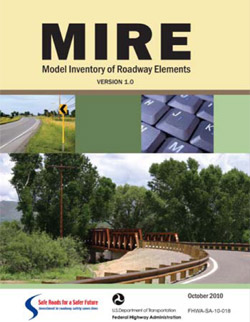 MIRE, the Model Inventory of Roadway Elements, is a listing of recommended roadway inventory and traffic elements important to safety management (3). MIRE is intended as a guideline to help transportation agencies improve their roadway and traffic data inventories. It provides a basis for a standard of what can be considered a good/robust data inventory and helps agencies move towards the use of performance measures (which will be discussed in detail in subsequent sections).
MIRE, the Model Inventory of Roadway Elements, is a listing of recommended roadway inventory and traffic elements important to safety management (3). MIRE is intended as a guideline to help transportation agencies improve their roadway and traffic data inventories. It provides a basis for a standard of what can be considered a good/robust data inventory and helps agencies move towards the use of performance measures (which will be discussed in detail in subsequent sections).
There are a total of 202 elements that comprise the MIRE listing. These elements are divided among three broad categories: roadway segments, roadway alignment, and roadway junctions. Examples of the MIRE data elements include:
- Roadway classification.
- Paved surface characteristics.
- Number and type of travel lanes.
- Shoulder, median, and roadside descriptors.
- Curve and grade information.
- Traffic control devices.
- Intersection features.
- Interchange and ramp descriptors.
- Pedestrian and bicyclist facilities.
- Traffic volumes.
There are many benefits to State and local transportation agencies expanding their inventories through the collection of MIRE elements. Having these additional data can help identify where the safety problems are, what those problems are, and how best to treat them. The MIRE Version 1.0 Report as well as additional information on MIRE, can be found at http://www.mireinfo.org.
The FHWA is now engaged in the next step in the MIRE development effort—testing the feasibility of a MIRE Management Information System (MIRE MIS). The MIRE MIS effort will involve working with pilot agencies to collect MIRE data and incorporate the data into their safety program. From this effort, FHWA will continue to publish technical guidance in the future, related to notable practices in data collection and MIRE MIS implementation.
